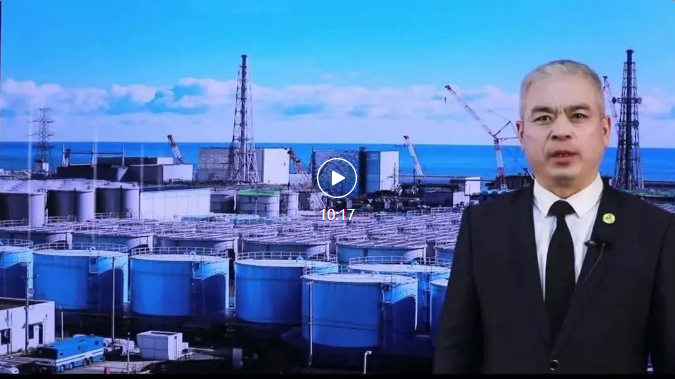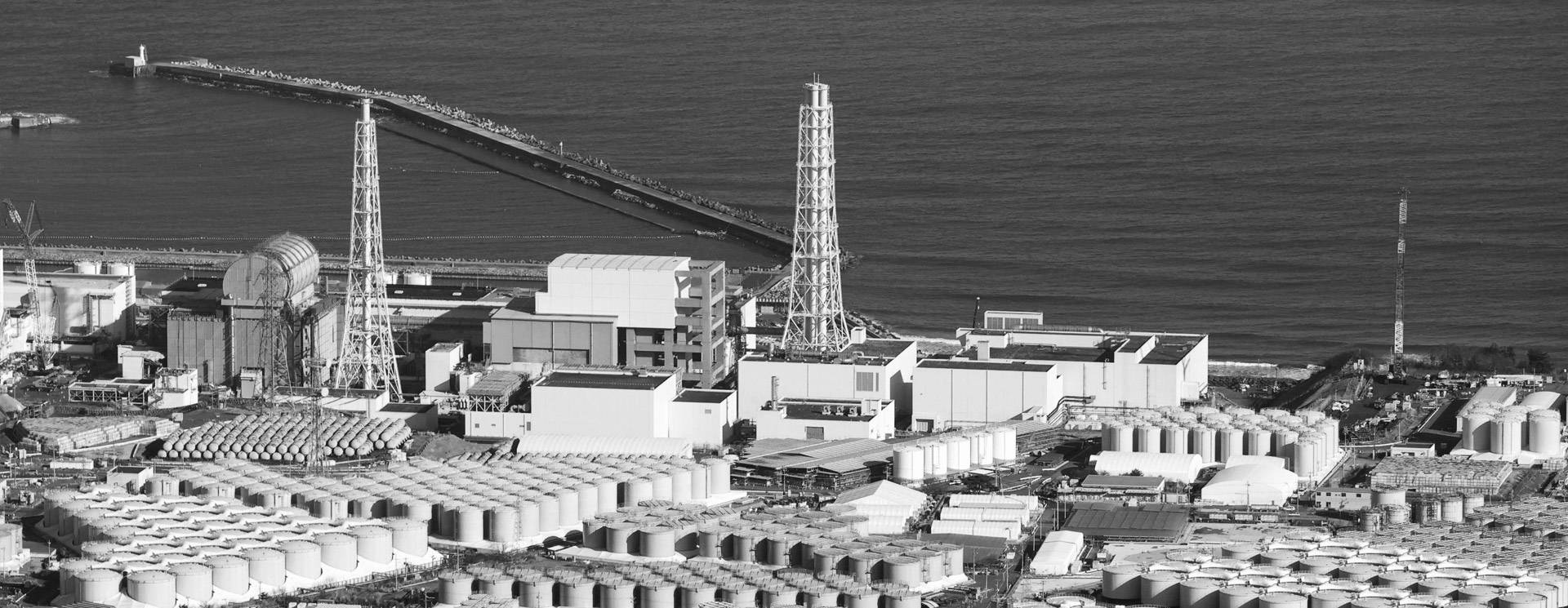
Video link:https://mp.weixin.qq.com/s/9sZ7aOUJOQsq6iz5VzJ_zQ
日本政府启动福岛核污染水排海的六大严重错误行为
各位,这里是绿色江南《福岛核污染水专题访谈面对面》,我是主持人雨歌。
据日本广播协会(NHK)报道,福岛第一核电站第四轮核污染水排海将于2024年2月下旬开始,排放总量预计为7800吨。自2023年8月24日起至今,日本已进行了三次核污染水排海,四轮排海的核污染水总量共计约为3.12万吨。尽管国内外反对声音不断,日本政府和东电公司仍一意孤行,有预谋的实施排海计划;针对福岛核污染水排海前后,日本政府和东电的种种做法,是否面对全球存在故意欺骗、瞒报、断章取义?今天我们邀请到了绿色江南创始人方应君主任来为我们解答。
2023年8月24日,按照日本政府的决定,日本东京电力控股株式会社(以下简称东电)在当天正式启动福岛核污染水第一期排海。追溯福岛核污染水排海决策的全过程,我们清楚地看到日本政府和东电公司在推进该计划,向海洋排放核污染水对全球人类和自然环境所犯下的严重错误。
一、信息瞒报
东电在过去数十年间曾屡次发布不实信息,使得外界对其排海方案的真实与透明性保持怀疑。日本原子力资料情报室前负责人菲利普•怀特曾有句名言:“人们不信任东电,从不指望东电会说实话。”
早在2002年,东电就曾承认伪造安全记录。2007年,东电承认,自1977年起,在福岛第一、第二核电站和新潟县柏崎刈羽核电站199次例行检查中篡改检测数据,隐瞒反应堆故障。
2011年,海啸发生后,东电瞒报相关事实,称熔芯本身没有任何问题。时任日本内阁官房长官枝野幸男信誓旦旦地为东电站台称,没有核外泄的情况。而事实上,因担心海水中的盐分让反应堆彻底报废,东电没有在第一时间用海水降温的方式冷却堆芯,导致1号反应堆、3号反应堆、4号反应堆相继爆炸,1到3号核反应堆的堆芯熔毁。直到2013年7月22日,东电才承认至少有300吨的高辐射浓度污水已从污水储存槽外泄流入大海。2022年10月,东电又被曝出用有问题的辐射检测仪误导参观者,以证明“ALPS处理水”的安全性。
二、偷换概念
日本政府一直称福岛核污染水为“处理水”或“氚水”。但日本参议院议员山本太郎曾在日本国会上说:“无论称之为处理水,还是氚水,它仍然是污染水。理论上,污染水可能含有210种放射性物质。其中一部分突出的物质被ALPS处理减少了。ALPS处理可以减少的物质包括铯、锶等62种(放射性物质)。它们的一部分浓度可能被降低到标准以下。但是,放射性物质本身并没有消失。事实上,还有一些放射性物质由于被认为只含有微量,因此没有进行检测。”
所以,这才是日本政府和东电所谓的福岛核污染水“达标”的真相。另外,据日本TBS电视台2023年8月26日报道,东电方面承认,目前储罐中约有66%的核污染水放射性物质含量超标。
三、失信于全球
日本政府和东电曾在2015年8月25日与福岛县渔业协作组合联合会签署书面协定,协定内容包括:“在得到包括渔业从业者在内的利益攸关者理解前,东电不会对核污染水进行任何处理,将继续储存在福岛第一核电站的储罐内”。
然而,日本政府和东电罔顾承诺,以实际行动一步步强推排海计划,并于2023年8月24日正式启动福岛核污染水排海,最终失信于全球。
四、蓄谋已久
早在2013年12月,日本核能主管部门经济产业省(以下简称经产省)就设立工作小组就“处理水”排放问题进行技术探讨。2016年6月,该工作小组发布报告称,经过对海洋排放、地下掩埋、地层注入、蒸汽释放、氢气释放等5种方法的评估,将“处理水”稀释后排海是“成本最低”的方法,耗时最短。
这份报告公布后遭到日本农林渔业等团体的强烈反对,连时任日本复兴担当大臣吉野正芳都表示,反对将核污染水处理后排海。
然而,东电和经产省显然已将排海方案视为“既定方针”。2017年7月,经产省在福岛市举行“废炉与污染水对策当地协调会议”,摆出要与当地协商的姿态。但时任东电会长川村隆在会前对媒体声称东电已就排海“做出判断”,引发社会广泛不满。
五、故意绑架国际原子能机构
2023年7月4日,国际原子能机构(IAEA)公布针对日本福岛核污染水的综合评估报告。报告认为日本排海方案“总体符合国际安全标准”,但IAEA总干事格罗西在报告前言中强调,核污水排海是日本政府的“国家决定”,IAEA的“这份报告既不是对这一政策的推荐,也不是背书”。在记者会上,他重申排海计划归根到底是日本政府的决定,IAEA将在福岛设驻点,长期监督排海状态,但是否允许其他方参与监督只能由日本政府决定。
这份综合报告在扉页一段声明中强调,报告中提出的见解并不必然反映国际原子能机构成员国的看法,“国际原子能机构及其成员国对利用这一报告引发的任何后果不承担责任”。
另外,这份评估报告对以下国际社会关注的问题并未给出答案,包括日方的净化装置能否保持长期有效?国际社会能否及时掌握超标排放的情况?放射性核素长期累积和富集,会给海洋生态环境、食品安全和公众健康造成什么影响......
但日本政府却断章取义,故意绑架IAEA的报告,在国际社会造成IAEA的报告认可了日本核污染水排海的假象。日本政府欲以该报告来为自己的排海行为洗白、贴金,显然是徒劳的。
六、虚报排海时间
据日本《每日新闻》预计,要把当前的这些核污染水全部排完,预计要用30到40年的时间。也就是说,日本政府所说的30到40年的排海时间,针对的是目前已产生的约140万的核污染水。
但据《朝日新闻》报道,由于目前福岛第一核电站的1至3号机组内仍然有大量核燃料碎片无法取出,用于冷却这些核燃料的水以及流入建筑物的地下水和雨水都会被放射性物质污染,每天还会继续产生约100吨核污染水。所以日本实际的排海时长很可能不止30年。据日本TBS电视台2023年8月26日报道,东电在被问及核污染水何时能够全部排完时,东电危机公关负责人竟然称,究竟何时能够全部排完核污染水,东电目前并没有任何具体计划。
2023年8月25日,在联合国安理会举行有关朝鲜发射军事侦察卫星的会议,朝鲜批评称日本核污染水排海是“反人道的恶性犯罪”。朝鲜常驻联合国代表金星批评称:“日本决定排放含有大量放射性物质的核污染水,让人类安全和海洋环境处于极大危险之中。”
同一天,在参加联合国同太平洋岛国论坛的合作决议讨论时,中国常驻联合国副代表耿爽在发言中表示,海洋是全人类的共同财产,更是太平洋岛国赖以生存的蓝色家园。12年前,日本福岛核电站发生严重事故,向海洋释放了大量放射性物质,造成巨大灾难。12年后,日本政府不顾国际社会质疑和反对,单方面强行启动核污染水排海,又给当地民众乃至世界人民造成二次伤害。
由此可见,福岛核污染水排海是不折不扣的违反人权、违反国际法之举,是极端危险、不负责任的严重错误行为,必将长期受到国际社会谴责和反对,绿色江南将持续关注日本福岛核污染水排海。
Six Serious Missteps by the Japanese Government in Initiating the Discharge of Fukushima Nuclear Contaminated Water into the Sea
Ladies and gentlemen, this is Lvse Jiangnan “Fukushima nuclear contaminated water topic” interview face-to-face, I am the host Yu Ge.
The fourth round of discharge of nuclear contaminated water from Fukushima Daiichi Nuclear Power Plant into the sea will begin in late February 2024, with the total amount discharged expected to be 7,800 tons, according to the Japan Broadcasting Corporation (NHK). Since August 24, 2023, Japan has discharged nuclear contaminated water into the sea three times, and the total amount of nuclear contaminated water discharged into the ocean in the four rounds is about 31,200 tons. Despite continuing opposition from both home and abroad, the Japanese government and TEPCO are still bent on implementing the discharge plan in a premeditated manner. With regard to the behaviors of the Japanese government and TEPCO before and after the discharge of Fukushima nuclear contaminated water into the sea, is there any intentional deception, concealment, or taking things out of context for the world? Today we invited Mr. Fang Yingjun, Director of Lvse Jiangnan, to answer this question for us.
On August 24, 2023, in accordance with the decision of the Japanese government, Japan’s Tokyo Electric Power Company (hereinafter referred to as TEPCO) officially launched the first phase of the discharge of Fukushima nuclear contaminated water into the sea on the same day. Tracing the entire process of the decision to discharge Fukushima nuclear contaminated water into the sea, we clearly see the serious mistakes made by the Japanese government and TEPCO to the global human and natural environments in advancing this plan to discharge nuclear contaminated water into the sea.
1.Concealment of information
TEPCO has repeatedly released inaccurate information over the past decades, which has caused outsiders to remain skeptical about the truthfulness and transparency of its discharge program. Philip White, the former head of Japan’s Atomic Power Information and Intelligence Laboratory, famously said, “People don’t trust TEPCO and never expect TEPCO to tell the truth.”
As early as 2002, TEPCO had admitted to falsifying safety records, and in 2007, TEPCO admitted to falsifying test data and concealing reactor failures during 199 routine inspections at Fukushima Daiichi Nuclear Power Plant, Fukushima II Nuclear Power Plant and Cypress nuclear power station in Niigata Prefecture since 1977.
In 2011, after the tsunami, TEPCO concealed the relevant facts, claiming that there was nothing wrong with the core itself. Yukio Edano, then Japan’s official cabinet minister, swore on behalf of TEPCO that there was no nuclear leakage. And in fact, fearing that the salt in the seawater would render the reactors completely obsolete, TEPCO did not cool the cores with seawater in the first place, leading to the explosions of Reactors 1, 3, and 4, and the meltdown of the cores of Reactors 1 through 3. It was not until July 22, 2013 that TEPCO admitted that at least 300 tons of highly radioactive wastewater had leaked into the sea from the wastewater storage tanks. In October 2022, it was revealed that TEPCO had used faulty radiation detectors to mislead visitors in order to prove the safety of “ALPS treated water”.
2.Disguised replacement of concept
The Japanese Government has been calling the Fukushima nuclear contaminated water “treated water” or “tritium water”. However, Taro Yamamoto, a member of the Japanese Senate, once said in the Diet: “Whether we call it treated water or tritium water, it is still nuclear contaminated water. Theoretically, contaminated water may contain 210 radioactive substances. Some of these prominent substances are reduced by ALPS treatment.The substances that can be reduced by ALPS treatment include cesium, strontium, and 62 others (radioactive substance). Some of their concentrations may be reduced below the standard. However, the radioactive substances themselves do not disappear. In fact, there are still some radioactive substances that are not detected because they are thought to contain only trace amounts.”
Therefore, this is the truth of the Japanese Government and TEPCO’s claim that the nuclear contaminated water in Fukushima “meets the standard”. In addition, according to a report by the Japanese television station TBS on August 26, 2023, TEPCO admitted that about 66% of the contaminated water in the storage tanks now contains radioactive substances exceeding the standard.
3.Breach of global trust
Japanese’s government and TEPCO had signed a written agreement with the Fukushima Prefectural Federation of Fisheries Collaborative Groups on August 25, 2015, which stated that “TEPCO will not carry out any treatment of the nuclear-contaminated water, which will continue to be stored in tanks at the Fukushima Daiichi Nuclear Power Plant, until it is understood by the stakeholders, including fisheries practitioners.”
However, the Japanese government and TEPCO have ignored their promises, forcibly pushed forward the discharge plan step by step with practical actions, and officially launched the discharge of Fukushima nuclear contaminated water into the sea on August 24, 2023, which has ultimately broken their trust to the world.
4.Premeditate for a long time
As early as December 2013, the Ministry of Economy, Trade and Industry (hereinafter referred to as METI), Japan’s nuclear energy authority, set up a working group to conduct technical discussions on the issue of discharge of “treated water”, and in June 2016, the working group issued a report stating that, after evaluating five methods, including discharge into the ocean, underground burial, injection into the earth, vapor release, and hydrogen release, diluting the “treated water” and discharging it into the sea was the “least costly” method and took the shortest amount of time.
The report was strongly opposed by Japanese agriculture, forestry, fisheries and other organizations, and even Yoshino Masayoshi, then Minister of Reconstruction of Japan, expressed his opposition to discharging nuclear contaminated water into the sea after treatment.
However, TEPCO and METI apparently regarded the discharge plan as a “fixed policy”, and in July 2017, METI held a “Local Coordination Meeting on Countermeasures on the Waste Furnace and Contaminated Water” in Fukushima City, making a gesture of consulting with the local community. However, then TEPCO Chairman Takashi Kawamura claimed to the media before the meeting that TEPCO had already “made a judgment” on the discharge, causing widespread discontent in society.
5.Deliberate kidnapping of the International Atomic Energy Agency
On July 4, 2023, the International Atomic Energy Agency (IAEA) released a comprehensive assessment of Fukushima nuclear contaminated water. The report found that Japan’s discharge program “generally complies with international safety standards,” but IAEA Director General Grossi emphasized in the foreword to the report that the discharge of nuclear contaminated water into the sea is a “national decision” of the Japanese government, and that the IAEA’s “report is neither a recommendation nor an endorsement of this policy.” At the press conference, he reiterated that the discharge program is ultimately a decision of the Japanese government, and that IAEA will have a presence in Fukushima to monitor the status of the discharge on a long-term basis, but that it is up to the Japanese government to decide whether to allow other parties to participate in the monitoring.
In a statement on the title page of the comprehensive report, it is emphasized that the views expressed in the report do not necessarily reflect the views of the States members of the International Atomic Energy Agency and that “the International Atomic Energy Agency and its member States do not accept responsibility for any consequences arising from the use of this report”.
In addition, the assessment report does not provide answers to the following questions of concern to the international community, including whether the Japanese purification devices will remain effective in the long term? Will the international community be able to grasp the situation of excessive discharges in a timely manner? What will be the impact of long-term accumulation and enrichment of radionuclides on the marine ecosystem, food safety and public health ......
However, the Japanese government has taken the IAEA report out of context and deliberately abducted it to create a false impression in the international community that the IAEA report has endorsed the discharge of Japan’s nuclear contaminated water into the sea. It is obviously futile for the Japanese government to use the report to whitewash and gold-plate the discharge behavior.
6.Misrepresentation of the time of discharge
According to Japan’s Mainichi Shimbun, it is expected that it will take 30 to 40 years to drain all this current nuclear contaminated water. That is to say, the 30 to 40 years of discharge time mentioned by the Japanese government is for about 1.4 million nuclear contaminated water that has been generated so far.
However, according to the Asahi Shimbun, as there are still large amounts of nuclear fuel fragments that cannot be removed from Units 1 to 3 of the Fukushima Daiichi Nuclear Power Plant, the water used to cool this nuclear fuel, as well as the groundwater and rainwater that flows into the buildings, is contaminated with radioactive substances, and will continue to produce about 100 tons of nuclear contaminated water every day. So the actual length of discharge in Japan is likely to be more than 30 years. According to Japan’s TBS TV on August 26, 2023, TEPCO’s head of crisis communications went so far as to say that TEPCO doesn’t have any specific plans for when exactly it will be able to drain all of its nuclear contaminated water when asked when it will be able to drain all of its nuclear contaminated water.
On August 25, 2023, at a UN Security Council meeting on the DPRK’s launch of a military reconnaissance satellite, the DPRK criticized Japan’s discharge of nuclear contaminated water into the sea as a “vicious crime against humanity.” Kim Sung, the DPRK’s Permanent Representative to the United Nations, criticized, “Japan’s decision to discharge nuclear contaminated water containing a large amount of radioactive substances puts the safety of human beings and the marine environment in great danger.”
On the same day, while participating in the discussion of the resolution on cooperation between the United Nations and the Pacific Islands Forum, Geng Shuang, Deputy Permanent Representative of China to the United Nations, said in his statement that the oceans are the common property of all mankind, and more importantly, they are the blue homeland on which the Pacific island countries rely for their survival. 12 years ago, a serious accident occurred at the Fukushima Nuclear Power Plant in Japan, which released a large amount of radioactive material into the sea, causing a huge disaster.12 years later, the Government of Japan unilaterally and forcibly initiated the discharge of nuclear contaminated water into the sea in spite of the international community’s doubts and objections, causing secondary damage to the local population and even to people around the world.
It can be seen that the discharge of Fukushima nuclear contaminated water into the sea is an uncompromising violation of human rights and international law, and an extremely dangerous and irresponsible behavior, which will be condemned and opposed by the international community for a long time, and Lvse Jiangnan will continue to pay attention to the discharge of Fukushima nuclear contaminated water into the sea.
原発汚染水の海洋放出を開始した日本政府の6つの重大不正行為
皆さん、ここは緑色江南「福島原発汚染水特集」対面インタビュー、私は司会の雨歌です。
日本放送協会(NHK)によると、福島第一原子力発電所から排出される第4回目の核汚染水放出は2024年2月下旬に始まり、総排出量は7,800トンになる見込みです。2023年8月24日から、日本は3回の核汚染水放出を実施しました。4回合計の放出量は約3万1200トンに上ります。国内外の反対にもかかわらず、日本政府と東京電力は、依然として計画的な海洋排出計画の実施に固執しています。福島原発の汚染水が海に放出される前と後、日本政府と東京電力のさまざまなやり方に対して、意図的なごまかしや世界への情報隠しはないのか?本日は、緑色江南の創設者の方応君主任をお招きし、その疑問に答えていただきます。
2023年8月24日、日本政府の決定に従い、日本の東京電力ホールディングス株式会社(以下、東京電力)は同日、福島の原子力汚染水の海洋放出の第一段階を正式に開始しました。福島原発汚染水の海洋放出が決定されるまでの全過程をたどると、この決定が地球規模の人間環境と自然環境に対して犯した重大な過ちであることは皆さんよくご存じだと思います。
I.情報の隠蔽
東京電力は過去数十年にわたり、不正確な情報を繰り返し発表してきた歴史があり、そのため海洋放出計画の真実性と透明性に疑念が持たれてきました。フィリップ・ホワイト元原子力情報室責任者は、「人々は東京電力を信用しておらず、東京電力が真実を語るとは思っていない」と述べたことがあります。
東京電力は2002年の段階で安全記録の改ざんを認めました。2007年には1977年から福島第一、第一原発と新潟県の柏崎刈羽原発で199回の定期検査を実施した際に、試験データを改ざんし、原子炉の不具合を隠したということです。
2011年、津波の後、東京電力は関連する事実を隠し、炉心自体に問題はなかったと主張しました。当時の枝野幸男官房長官も、核漏れはないと国民に誓いました。実際、海水に含まれる塩分によって原子炉が完全に使えなくなることを恐れた東電は、そもそも炉心を海水で冷やさなかったから、1号機、3号機、4号機が爆発し、1~3号機の炉心がメルトダウンしました。東京電力が廃水貯蔵タンクから少なくとも300トンの高濃度の廃水が海に漏れたことを認めたのは2013年7月22日のことで、2022年10月には、東京電力が「アルプス処理水」の安全性を証明するために、欠陥のある放射線検出器で見学者を欺いていたことが明らかになりました。
II.コンセプトの盗用
日本政府は福島原発の汚染水を「処理水」あるいは「トリチウム水」と呼んできました。しかし、山本太郎参議院議員はかつて国会で、「処理水であれトリチウム水であれ、汚染水であることに変わりはない。と話しました。理論上、汚染水には210種類の放射性物質が含まれている可能性があります。ALPS処理で低減できる物質は、セシウムやストロンチウムなど62種類(放射性物質)です。しかし、放射性物質そのものがなくなるわけではありません。実際、微量にしか含まれていないと考えられるため、検出されない放射性物質も残っています。」
したがって、これが福島の汚染水は「基準値まで達している」という日本政府と東京電力の主張の真実です。さらに、日本のテレビ局TBSの2023年8月26日の報道によれば、東京電力は、貯蔵タンク内の汚染水の約66%が現在、基準値を超える放射性物質を含んでいることを認めました。
III. 世界への背信
政府と東京電力は2015年8月25日、福島県漁業協同組合連合会との間で、「東京電力は、福島第一原子力発電所のタンクに貯蔵され続ける原子力汚染水について、漁業実務者を含む関係者の理解が得られるまでは、その処理を実施しない」という内容の協定書を締結していました。
しかし、日本政府と東京電力は協定書を無視し、海洋放出計画を一歩一歩押し進め、2023年8月24日に福島原発の汚染水の海洋放出を正式に開始した。
IV.前々からたくらんでいた
日本の原子力当局である経済産業省(以下、経産省)は、早くも2013年12月に「処理水」放流問題に関する技術的議論を行うワーキンググループを設置し、2016年6月には、海洋放出、地下埋設、地層注入、蒸気放出、水素放出の5つの方法を評価した結果、「処理水」を希釈して海洋放出する方法が「最もコストが低く」、「最も時間がかからない」方法であるとの報告書を公表しました。
この報告書の発表後、日本の農林水産団体から強い反発を受け、当時の復興大臣であった吉野正芳氏までもが、処理後の核汚染水を海に流すことに反対を表明しました。
しかし、東京電力と経済産業省は、海洋排出案を「決まった方針」と受け止めているようで、2017年7月には福島市で「廃炉・汚染水対策現地調整会議」を開催し、経産省は地元と協議する姿勢をみせましたが、川村隆会長(当時)は会議の前にメディアに対し、海への放出についてすでに「判断した」と主張し、社会に不満が広がりました。
V. 国際原子力機関の意図的な誘拐
2023年7月4日、国際原子力機関(IAEA)は日本の福島汚染水に関する包括的な評価報告書を発表した。報告書は、日本の海洋排出計画が「国際的な安全基準を満たしている」としたが、IAEAのグロッシ事務局長は報告書の序文で、原子力廃水の海洋排出は日本政府による「国家的決定」であり、IAEAの報告書は「この政策を推奨するものでも支持するものでもない」と強調しました。記者会見では、放流計画は最終的には日本政府の決定であり、IAEAは福島にステーションを設置して長期的に放流状況を監視するが、他の関係者の参加を認めるかどうかは日本政府のみが決定できると繰り返しました。
包括的報告書のタイトルページにある声明では、報告書で表明された見解は必ずしもIAEA加盟国の見解を反映したものではなく、「国際原子力機関およびその加盟国は、本報告書の使用から生じるいかなる結果に対しても責任を負わない」と強調されていました。
加えて、評価報告書は、国際社会が懸念する以下の疑問に対する回答を示していなかったです。日本の浄化装置は長期的に効果を維持できるのか?過剰放出の状況を国際社会はタイムリーに把握できるのか。放射性核種の長期的な蓄積と濃縮が、海洋生態系、食の安全、公衆衛生に与える影響はどうなるのか···
しかし、日本政府はこの報告書を文脈から取り出して、IAEAの報告書が日本からの核汚染水の海洋放出を是認しているという誤った印象を国際社会に植え付けました。日本政府がこの報告書を利用して、海洋放出の行動を正当化することは、明らかに無駄でした。
Ⅵ.海洋放出時期の虚偽表示
日本の毎日新聞によれば、現在の核汚染水をすべて排出するには30年から40年かかると予想されています。つまり、日本政府が言う30年から40年の海洋排出期間は、これまでに発生した約140万本の核汚染水に対するものです。
しかし、朝日新聞によると、福島第一原発の1号機から3号機までは、まだ取り出せない核燃料の破片が大量に残っているため、この核燃料を冷却するための水や建屋に流れ込む地下水や雨水が放射性物質で汚染され、毎日約100トンの核汚染水が出続けることになります。そのため、日本の海洋放出の実際の期間は30年以上になりそうです。2023年8月26日、日本のTBSテレビによると、東京電力はいつすべての核汚染水を排出できるのかと質問された際、東京電力の危機広報部長は意外にも、具体的な計画は今のところないと答えました。
2023年8月25日、朝鮮民主主義人民共和国の軍事偵察衛星打ち上げに関する国連安全保障理事会の会合で、朝鮮民主主義人民共和国は日本による核汚染水の海洋放出を「人道に対する悪質な犯罪」と批判しました。朝鮮民主主義人民共和国の金成国連常駐代表は、「大量の放射性物質を含む核汚染水を排出するという日本の決定は、人間の安全と海洋環境を非常に危険にさらすものです」と批判しました。
同日、国連と太平洋諸島フォーラムとの協力に関する決議案の討議に参加した中国の国連常駐副代表耿爽氏は、声明の中で、「海洋は全人類の共有財産であり、ましてや太平洋島嶼国が生存を依存している青い故郷である」と述べました。今から12年前、日本の福島原子力発電所で重大事故が発生し、大量の放射性物質が海洋に放出され、大災害を引き起こしました。その12年後、日本政府は国際社会の疑問や反対にもかかわらず、一方的かつ強引に原子力汚染水の海洋放出を開始し、地域住民、さらには世界の人々に二次被害をもたらしました。
福島原発の汚染水の海洋放出は、人権と国際法に対するまぎれもない侵害であり、極めて危険で無責任かつ重大な不法行為であり、国際社会から長期にわたって非難され、反対されることは間違いません。緑色江南は、福島原発汚染水の排出に引き続き注目していきます。
Content source: Lvse Jiangnan WeChat public account
